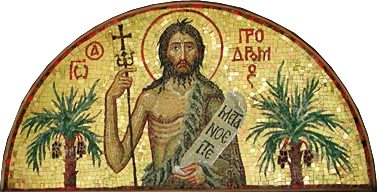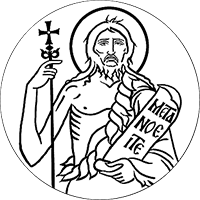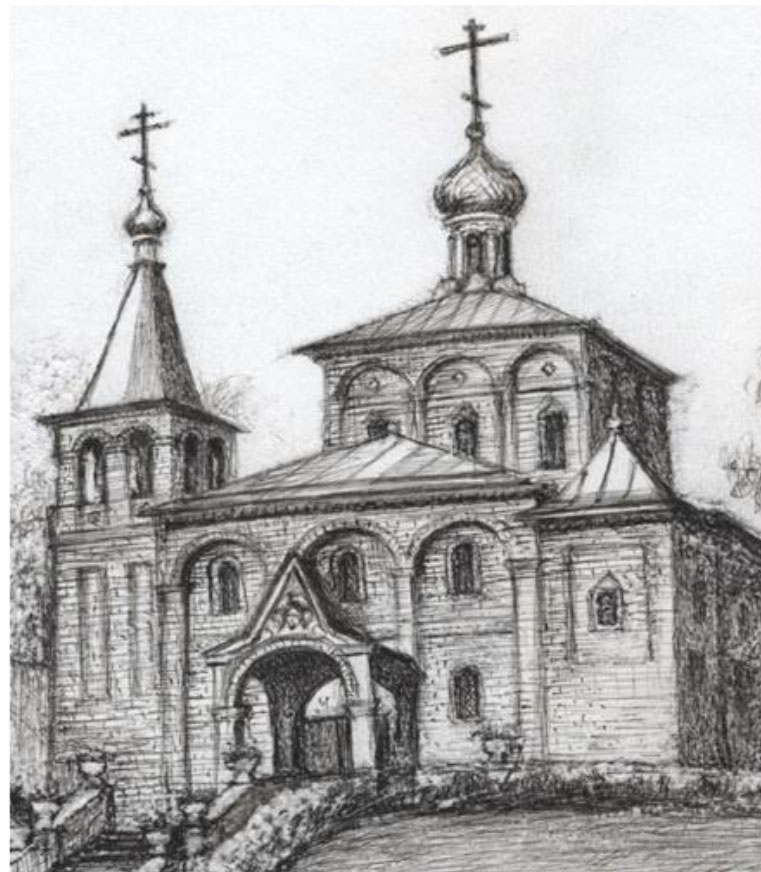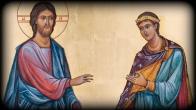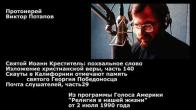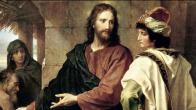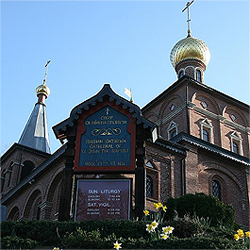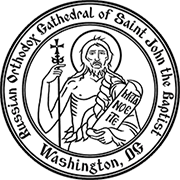You are here
August
- July 20/August 2 -- "Abalatskaya", Galich-Chukhloma "Tenderness"
- July 23/August 5 -- "Pochaev", "The Joy of All Who Sorrow" (with coins) in Petersburg
- August 1/14 --"Antiphonetria" [She Who Retorts] Icon
- August 8/21 -- "Tolga" Icon
- August 12/25 -- "The Seven Arrows"
- August 13/26 -- "Minsk" Icon, "Of the Passion"
- August 14/27 -- "Besednaya"
- August 15/28 -- "Khakhulskaya", "Iveron" Icon in Mozdok, "Tinos" Icon
The Abalatskaya Icon of the Mother of God
20 July / 2 August
This miraculous icon, the Abalatskaya Icon, is named after the Siberian village of Abalak in the Diocese of Tobolsk, a village in which a monastery was founded in 1783. During the reign of Tsar Mikhail Fyodorovitch, and during the episcopacy of Archbishop Nektary of Tobolsk, a widow named Maria lived alone in the Abalak country churchyard. In 1636, fifty years after Tobolsk was established, that widow, lightly dozing in her shack, had a vision in which she saw the Image of the Most-holy Theotokos of the Sign suspended in the air; depicted on the right was Holy Hierarch St. Nicholas the Wonder-worker, and on the left, the Venerable St. Mary of Egypt. She heard a voice order her to announce this vision to the people, and to tell them that they should build a new church, dedicated to the Sign Icon of the Most-holy Theotokos, to the right of the old Church of the Holy Transfiguration in the Alabak churchyard. The new church, dedicated to the Sign Icon that is in ancient Novgorod, was to have two side chapels – one to St. Nicholas, and the other, to St. Mary of Egypt. Maria awoke, but was too timid to dare tell anyone about the vision. The vision was repeated four times.
The fourth vision was quite a significant one, and Maria could no longer keep it secret. She was on her way from Abalak to Tobolsk, when, going up the hill toward the town, she suddenly stopped as if in a fog. Before her there appeared something like a pillar of clouds, and on the pillar was the image of the Sign of the Mother of God and the image of St. Mary of Egypt. St. Nicholas, as if alive, was standing on the ground, and angrily said to her, “Why are you slow to announce your visions and to relate the commands to the people?” After that, the widow began to tell every one of her visions and she related them to Archbishop Nektary before everyone in the Cathedral. Everyone believed the pious widow’s accounts. After submitting her to an exhaustive inquiry, the Archbishop blessed the residents of Abalak to construct the church; many of the residents of Tobolsk participated in that work. By God’s providence, a patronal icon was prepared for that church.
For many years, a certain peasant named Euphemy had lain paralyzed. It happened that a certain Paul, an indigent who received support from Euphemy, came by and said to him, “Euphem! A church is being built at God’s direction in Abalak; it is dedicated to the Sign Icon of the Theotokos, to St. Nicholas, and to St. Mary of Egypt. Make a vow to have a patronal icon painted for that church. Perhaps, in return for your faith and diligence, the Lord will forgive you and will free your from your illness.” Euphemy heeded him as if he were the Angel of the Lord, and the same day vowed to prepare an icon of the Sign of the Mother of God, with St. Nicholas and St. Mary of Egypt at either side. The Lord heard his prayers, and in the afternoon of the same day, he regained the use of the right side of his body. The next day, Euphemy dispatched a request to His Eminence Nekary for permission to paint a patronal icon for the new church in Abalak. Upon receiving a hierarchical blessing, he ordered the painting of an icon by the then most accomplished artist in Siberia – Protodeacon Matthew of the Tobolsk Cathedral. All the time that the icon was being painted, Euphemy prayed; each day he became stronger. Finally, feeling himself restored to health, he himself went to the artist and with his own hands brought the Icon to the Cathedral to be blessed.
Several copies of the Abalatskaya Icon exist in various places in Siberia. They are revered by the local populace, and at certain times are carried in procession to surrounding towns and settlements.
Chukhloma (Galich) Icon
20 July / 2 August
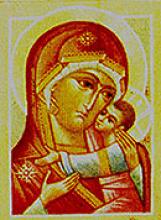 This image appeared in the year 1350 to Venerable Abramius of Galich, who, with the blessing of Venerable Sergius of Radonezh, had come north to pursue spiritual struggle. On the barren shore of the Galich lake, near a great hill covered by dense forest, he turned to the Mother of God in prayer, asking her blessing for his spiritual struggle. After praying, the venerable one sat down to rest. Suddenly, he beheld a bright light on the neighboring hill, and he heard a voice saying: "Abramius, ascend the hill upon which stands the icon of My Mother." The venerable one climbed up the hill from which the light was gleaming and indeed discovered there, in a tree, an icon of the Mother of God with the Pre-eternal Infant. Deeply moved, and thanking the Lord, the holy struggler received the image which had miraculously appeared. Strengthened by prayers to the Most Holy Theotokos, he built a chapel on the blessed site and in it placed the Icon. Some time later, the Prince of Galich, Dimitry Feodorovich, having learned of the elder's arrival, requested that he bring the Icon to him. Venerable Abramius crossed the Galich lake by boat and, accompanied by clergy and by a multitude of people, transferred the miraculous image to the cathedral church of the city of Galich.
This image appeared in the year 1350 to Venerable Abramius of Galich, who, with the blessing of Venerable Sergius of Radonezh, had come north to pursue spiritual struggle. On the barren shore of the Galich lake, near a great hill covered by dense forest, he turned to the Mother of God in prayer, asking her blessing for his spiritual struggle. After praying, the venerable one sat down to rest. Suddenly, he beheld a bright light on the neighboring hill, and he heard a voice saying: "Abramius, ascend the hill upon which stands the icon of My Mother." The venerable one climbed up the hill from which the light was gleaming and indeed discovered there, in a tree, an icon of the Mother of God with the Pre-eternal Infant. Deeply moved, and thanking the Lord, the holy struggler received the image which had miraculously appeared. Strengthened by prayers to the Most Holy Theotokos, he built a chapel on the blessed site and in it placed the Icon. Some time later, the Prince of Galich, Dimitry Feodorovich, having learned of the elder's arrival, requested that he bring the Icon to him. Venerable Abramius crossed the Galich lake by boat and, accompanied by clergy and by a multitude of people, transferred the miraculous image to the cathedral church of the city of Galich.
That day, many sick people received healing from the Icon. When Venerable Abramius related an account of the Icon's miraculous appearance, the prince donated funds with which to build a monastery. Soon afterward, a church dedicated to the Dormition of the Most Holy Theotokos was erected, and around it grew a monastery. Subsequently, Venerable Abramius established several other monasteries, of which the last was the Chukhloma Monastery, not far from the town of Chukhloma. The spiritual struggler came to be known as Abramius of Chukhloma, after the name of that monastery, and the miraculous Icon became known as the Galich-Chukhloma Icon. This Icon is also celebrated on 28 May and 15 August.
"Pochaev" Icon
23 July / 5 August; September 8/21
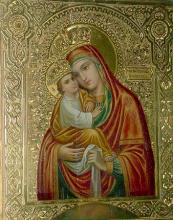 The Pochaev Dormition Lavra is one of four lavras in the Russian Empire. It is a bastion of Orthodoxy inИкона Божией Матери Почаевская South-western Rus’, in Volhyn (now part of Ukraine’s Ternopol Province). This is a place where throughout the ages, borders between empires, civilizations, and world views clashed. Until 1914, the Austro-Hungarian border was a mere 8 versts [1 verst = 1.07 km.] away, and the fame of Pochaev’s holy objects extended not only to neighboring Galicia, but also to Bulgaria, Bosnia, and Serbia.
The Pochaev Dormition Lavra is one of four lavras in the Russian Empire. It is a bastion of Orthodoxy inИкона Божией Матери Почаевская South-western Rus’, in Volhyn (now part of Ukraine’s Ternopol Province). This is a place where throughout the ages, borders between empires, civilizations, and world views clashed. Until 1914, the Austro-Hungarian border was a mere 8 versts [1 verst = 1.07 km.] away, and the fame of Pochaev’s holy objects extended not only to neighboring Galicia, but also to Bulgaria, Bosnia, and Serbia.
At one time, this had been a forest-covered hill, where monks carried on their spiritual struggle living in caves. They were hermits from the Kiev Caves who had taken refuge here after the mother of all Russian cities Kiev was laid waste in 1240 by Baty [Khan].
In that same 13th Century, two of the nameless strugglers, along with the local shepherd Ivan the Barefoot, were made worthy to witness a great miracle: the appearance of the Most Pure One in a pillar of fire standing above the Pochaev hillside. In the solid limestone on which the Theotokos had been standing in prayer that night, there remained the print of her right foot; that footprint is the most ancient of the holy treasures of Pochaev. The footprint is always full of pure healing water from a spring that burst forth on that same night.
At the base of the hill, the monks soon erected the first stone church, in honor of the Dormition. Now the enormous Dormition Cathedral, built in the 1780s in the baroque style, and encompassing the hill itself, the caves, the Footprint, and the sacred spring, stands on the site. Rising like a cliffside set amid the boundless surrounding fields, the cathedral is visible many kilometers from the town of Pochaev itself.
However, back in the 13th Century, with the collapse of Rus’ and the gradual falling away of its Southwestern lands, the monastery fell into decline as well.
The monastery was re-established at the turn of the 16th Century. In 1559 the Greek Metropolitan Neophyte, who was traveling through the area stopped for the night at the home of the pious landowner Anna Goiskaya. In thanks for her cordial hospitality, he left the housewife a memento: an image of the Theotokos painted in Constantinople.
For three decades, the icon remained in the house chapel in the village of Urlya (about 8 versts from Pochaev). Then it began to emit a mystical radiance at night, a radiance like unto the pillar of fire in which 300 years earlier, the Most-holy One herself had appeared there. Philipp Kozinsky, who was the brother of the lady of the house and who had been blind from birth, regained his sight before that Icon. The Goisky family interpreted the miracle as a Queen of Heaven’s expression of her intention to abide in the restored Pochaev Monastery, to which they gave the Icon, along with generous gifts.
After Anna’s death in 1644, all of the surrounding lands were inherited by one of her kinsmen who hated Orthodoxy, and who robbed the Monastery and seized the Icon. However, he and his wife were immediately visited with a brutal sickness from which they recovered only after they had returned the Miraculous Icon to the Monastery.
Since that time the Miraculous Icon has been housed in a frame in the shape of a radiant star, in the third row of the Dormition Cathedral iconostasis. On special occasions, it is lowered down from its place so that pilgrims might venerate it. The "Pochaev" Icon has gained renown for a host of miracles.
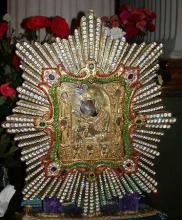 The "Pochaev" Icon is of the type known as the Eleoussa Icon. The Pre-eternal Infant sits on her rightПочаевская икона Божией Матери arm. In her left is a cloth partially covering the Son of God. Usually, on copies of the Miraculous Icon, the Footprint of the Theotokos is also depicted below her image.
The "Pochaev" Icon is of the type known as the Eleoussa Icon. The Pre-eternal Infant sits on her rightПочаевская икона Божией Матери arm. In her left is a cloth partially covering the Son of God. Usually, on copies of the Miraculous Icon, the Footprint of the Theotokos is also depicted below her image.
Through the intercession of the Most-holy One, the Monastery remained faithful to Orthodox even under Polish-Lithuanian rule, resolutely opposing the Uniate assaults upon the area.
The Theotokos also manifested her marvelous help during the siege of the Monastery by the Turks in the year 1675, when the Hagarites completely surrounded the Monastery’s wooden structures and threatened to put them to the torch. The Monks appealed to the Image of our Sovereign Lady with prayers that she intercedes.
Then the Turks witnessed an awesome sight in the sky above the Cathedral: The Most-pure One hovered above her Monastery in radiant splendor, surrounded by the Angelic Hosts armed with flaming swords, and extending her Omophorion over the Monastery. Next to the Sovereign Lady stood Venerable St. Job, the recently deceased (+ 1651) Abbot of Pochaev, who prayed along with his earthly brethren for her assistance.
Blinded by the heavenly apparition, the Hagarites turned on one another, and fled from the site which had so terrified them.
Despite its firm resolve to remain Orthodox, in 1713 the Pochaev Monastery was forcibly turned over to the Uniates, and remained under them until the Polish rebellion of 1831. Returned to the bosom of Orthodoxy, in 1833 the Monastery was granted the great honor of being called a Lavra, and ranked as “fourth among the Lavras in Russia” (along with the Kiev Caves, Holy Trinity-St. Sergius, and Alexander Nevsky Lavras).
In Moscow, there is a greatly venerated "Pochaev" Icon in the Lefortovo Church of Sts. Peter and Paul. This church was never closed down, and here the Icon was brought at the height of atheist persecutions of the 1930s.
The "Joy of All Who Sorrow" Icon of the Mother of God in the Tikhvin Chapel of the glass factory in St. Petersburg (the icon “with coins” or “with pennies.”)
23 July / 5 August
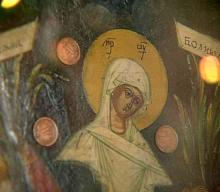 There are several disparate accounts of how the Icon came to be in the Tikhvin Chapel. According to the first, the Icon was donated by S.I. Matveev, a merchant with a business relationship with the factory. The Icon belonged to his mother, nee Kurakina; the “Joy of All Who Sorrow” Icon came into their family after being fished out of the Neva River . According to the second version, the Icon came to rest on the river shore at the place where the Chapel had been built. According to a third account, a certain Ladoga merchant barely escaped death in a storm on the Neva , then donated the Icon to the Chapel. It is quite probable that these traditional accounts initially pertained to the Tikhvin Icon of the Mother of God, but later came to be attributed to the “Joy of All Who Sorrow” Icon.
There are several disparate accounts of how the Icon came to be in the Tikhvin Chapel. According to the first, the Icon was donated by S.I. Matveev, a merchant with a business relationship with the factory. The Icon belonged to his mother, nee Kurakina; the “Joy of All Who Sorrow” Icon came into their family after being fished out of the Neva River . According to the second version, the Icon came to rest on the river shore at the place where the Chapel had been built. According to a third account, a certain Ladoga merchant barely escaped death in a storm on the Neva , then donated the Icon to the Chapel. It is quite probable that these traditional accounts initially pertained to the Tikhvin Icon of the Mother of God, but later came to be attributed to the “Joy of All Who Sorrow” Icon.
On July 23, 1888, thunderstorms developed in St. Petersburg and its surrounding area. A powerful lightning bolt struck the Chapel at the glass factory, setting fire to its interior walls, burning the icons, and utterly shattering the collection box, but not touching the Icon of the Mother of God. The thunder clap knocked the Icon to the floor. At the same moment, the image of the Mother of God, which time and smoke had severely darkened, seemed to lighten and become renewed. Moreover, somehow twelve copper coins from the collection box affixed themselves to various spots on the Icon.
By that same evening, news of the miraculous preservation of the Icon had spread throughout the capital, and the next day great multitudes of people, amazed at the miraculous sign of God’s mercy, surrounded the chapel from morning till night. Each day there were ever greater numbers of the faithful. From St. Petersburg , word of the Holy Icon spread throughout Russia , and from every point of the compass, faithful came to pray. Through God’s mercy, the Icon of the Mother of God soon gained renown for working miracles.
On October 6, 1890, everyone praying in the chapel was eyewitnesses to the amazing healing of Nikolai Gratchev, a 14-year-old who suffered from seizures and paralysis of the arms. Physicians had concluded that his long-standing illness was incurable. It so happened that the sick boy’s room was suddenly brightly illuminated with an unearthly light, and the youth saw the Most-immaculate Virgin, St. Nicholas the Wonderworker, and a certain Holy Hierarch wearing a white klobuk [monastic headgear]. The Mother of God ordered the youth to go to the chapel, and said that after doing so, he would be healed. The youth did as he had been directed. He came to the chapel, venerated the Icon, and his seizure disorder left him. His arms regained their strength, and from that moment, he was completely healthy.
The Icon depicts the Most-immaculate Virgin at full-length, with arms stretched outward. Her face is turned somewhat to the left. Her outer garments are dark blue, while the inner garments are dark red. Her head is covered with a white shawl, and ringed by a golden nimbus. In the clouds above her, the Savior sits enthroned, holding the Holy Gospels in His left hand, and blessing with His right. On either side are depicted Angels and people who are suffering.
The finding and miraculous renewal of a copy of the “Joy of All Who Sorrow Icon With Coins” in St Petersburg in 1996.
On August 2, 1996, members of the community of the Church of Christ ’s Glorious Resurrection at the entrance to the Smolensk Cemetery were clearing the area in preparation for repairs and restoration work (the church had just been turned over to the diocese). They were tearing down garages near the Western entrance to the church, had removed the foundation, and were clearing the property when they saw a darkened board. The earthmover’s scoop gouged it deeply, almost breaking it in half. Alexei A., a woodworker at the metokhion lifted up the board. On the back there was a barely discernible, but recognizable depiction of the Joy of All Who Sorrow Icon. Nikolai Bondarev, administrator of the metokhion, took the Icon home to wash it in rose oil. When he took it out, he was amazed to see that it had become considerably brighter. Over the course of the next six months, it renewed itself even more.
The story of the finding of the Holy Icon was reflected in a special affidavit signed by Deacon Nikolai and those who served at the metokhion. The Icon is a lithograph measuring 28 х 22 cm, on a thin fabric mounted to a wooden board stabilized with shponki [wooden slats inserted into grooves cut into the back of the icon mounting board, to minimize warping]. The edges show some damage, there are some little holes made by insect larvae, and some details are slightly worn, but overall, the Icon, after lying in the damp earth for who knows how long with no protection from the elements, had been preserved whole. An inscription on the Icon attests to the fact that it is an exact copy of the Mother of God “Joy of All Who Sorrow” in the chapel at the glass factory in St. Petersburg . This is how it appeared during a thunderstorm on July 23, 1888. On that day, lightning struck the collection box, and small coins miraculously affixed themselves to the Icon, which later manifested a multitude of other miracles and healings, and which now is in the Church of the Holy Trinity known as the “Kulitch and Pascha” church.
The finding of the image in 1996 took place three days before the Feastday of this Icon (23 July/5 August). Another coincidence that was no accident: Literally several meters from the place where it had appeared is the memorial over the grave of Archpriest Alexander Mikhailovitch Ivanov, (2/13/1857 - 1/4/1912) – rector of the Joy of All Who Sorrow Church at the glass factory, where the miraculous and revered Icon of the Theotokos “with coins” had been.
The “Antiphonetria” [She Who Retorts] Icon
1/14 August
The Icon of the Mother of God known as the Antiphonetria Icon is in the Konstamonitou Monastery, and was glorified in the following manner:
On a certain August 1, on the eve of the Feast of the Holy Protomartyr Archdeacon Stephen, to whom the Monastery was dedicated, the ecclesiarch Agathon (in schema Zachary), was seized with great sorrow: the patronal feast of the Monastery was at hand, and its supplies were so low that on such a festal day, there was not even oil with which to light the vigil lamps!
At nightfall, Agathon turned to the Mother of God in tearful and fervent prayer. He prayed so fervently before her holy Icon that, exhausted by his efforts and his sorrow, he sat down in the stasidion before the icon, and immediately fell asleep. In a dream, he heard a voice coming from the Holy Icon of the Mother of God, and ordering him not to mourn or lament, as the church vessel was full of oil, and the closets contained everything needed to sustain the Monastery.
Afterwards, ecclesiarch Agathon awoke, and amazed by what he had heard in his sleep, he hurried to examine the container in which the church oil was stored. How great was his joy at seeing that it was filled to the brim! He immediately told Hilarion, Prior of Konstamonitou, and the other brethren, of his vision. They all went to inspect the Monastery stores, and found there all of the supplies, in great abundance. Ecclesiarch Agathon rejoiced at such a surprise, one enabling him to decorate the church with vigil lamps on such a festive day for the Monastery. The brethren were also filled with great joy. Together with Abbot Hilarion, they spent the entire night in prayerful vigil, singing the praises of the miracles of our Heavenly Sovereign Lady.
Following this occurrence in the Konstamonitou Monastery, the Miraculous Icon of the Mother of God before which ecclesiarch Agathon had prayed became known as the “Antiphonetria” Icon. Now it hangs on the right wall of the Cathedral Church . Since the miraculous event, a vigil lamp has been perpetually burning before the Icon.
In addition to the Miraculous Icon of the Mother of God, there are two other Icons of the Theotokos bearing the name “Antiphonetria”: one at Vatopedi on Mt. Athos and the “Akathist – Zographou” Icon. The history of these icons may be found in the Menaion for January 21 and October 10, respectively.
"Tolga" Icon of the Most Holy Theotokos appeared on August 8, 1314, to the hierarch Prokhor of Rostov (who, upon tonsure into the schema, received the name Triphon). Traveling about the diocese, the hierarch visited the land surrounding White Lake, and from there went down the rivers Sheksna and Volga to Yaroslavl. Toward nightfall, a stop was made about four and a half miles from Yaroslavl, on the right of the Volga, across from its confluence with the river Tolga. At midnight, while they were all asleep, the hierarch awakened and saw a bright light illuminating the surrounding area. The light was emanating from a pillar of fire on the opposite bank, to which a bridge extended. Taking his staff, the hierarch crossed to the other side, and approaching the pillar of fire, saw within it, in mid-air, an icon of the Most Holy Theotokos. Astonished by the apparition, the hierarch prayed for a long time; upon turning back, he forgot to take his staff.
The next day, when, after serving Matins, the hierarch Prokhor was about to board the boat to continue his journey, they began to search for his staff, but could not find it anywhere. Then the hierarch remembered that he had left his staff on the opposite bank, where he had gone across the miraculous bridge. He related his vision to the others. The servants whom he dis-patched to go by boat to the other shore returned with the news that among the trees in the forest they had seen an icon of the Mother of God, and next to it, the episcopal staff. The hierarch, who, together with all of the people, immediately crossed over to the other side, recognized the icon which had appeared to him. After fervent prayers before the icon upon that site, they cleared the trees, and there dedicated a church. As soon as the residents of Yaroslavl learned of this, they came to the indicated spot. By noon, the church had already been erected, and in the evening the hierarch performed the consecration, dedicating the church to the Entry into the Temple of the Most Holy Theotokos. He brought the icon into the church, and ordained that it be celebrated on the date of its appearance. Around this church, Prokhor established the Tolga Monastery, which at the present time is a convent.
"The Seven-Arrows" Icon
12 / 26 August
Before the Revolution of 1917, this miracleworking icon was in the St. John the Theologian – Bogolyubsk-Seven-Arrow Church, a small country church on the banks of the Toshin River, not far from the town of Vologda.
The Mother of God is depicted in an unusual pose, alone, without the Pre-eternal Divine Infant. She is pierced by seven arrows: four on her left side, and three on her right. The following is an account of the earliest glorification of this icon: A certain peasant of the Kandikovsky District who as the result of disease had for many years suffered with generalized weakness and a limp, had a dream in which he learned that he would be healed if he visited the St. John-Bogolyubsk church and found the icon of the Mother of God in the bell-tower. Twice he went there, related his dream, and asked permission to enter the bell-tower. However, they did not believe him, and his request was denied. Finally, the third time, they took pity on him and allowed him into the bell-tower. He immediately found the Holy icon which he had seen in his dream. It was being used as a floorboard on a stairway landing. They washed the icon of the dirt and bird droppings covering it. The sick peasant requested that a moleben be served before it, and, thereafter, was healed.
Much time passed, with nothing again heard of this icon until 1830, at a time when cholera was rampant in Vologda. The terrified residents ran for help to the Queen of Heaven, and taking up her Seven-arrows and Seven-city icons, carried them about the city in a solemn Procession of the Cross. The epidemic visibly abated, and soon the cholera entirely disappeared. From that time on, the icon was glorified through many miraculous healings of the sick.
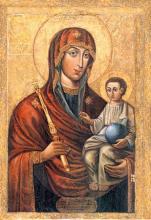 This icon is very ancient; according to tradition it was written by the Evangelist Luke. At the end of the 10th century it was translated, together with other Greek (style) holy icons, by the Equal-of-the-Apostles Great Prince Vladimir from the Greek city of Korsun (Khersones) to Kiev. In Kiev it was installed in the church dedicated to the Nativity of the Mother of God, which was called "The Tithe" Church, since the Grand Duke granted one tenth of all his holdings to support it. The Icon remained in Kiev for over 500 years, and was glorified by many miracles. Around the year 1500, during the civil war between the Volga and Crimean Tatars, Kiev was looted. The church of "The Tithe" was also ransacked and an insolent Tatar pried the rich riza from the miracle-working icon, discarding the icon itself into the Dnieper River. It seemed that the ancient holy icon had been lost, but after a certain time the icon revealed itself in the Svislochi River, opposite the ancient castle of the Minsk princes. It came to be noticed because a pillar of light emanated from it, and reached into the heavens. The icon was placed in the castle's Church of the Nativity of the Mother of God. This happened on August 13 by the old calendar. Since then it was decided to celebrate the Icon on that day.
This icon is very ancient; according to tradition it was written by the Evangelist Luke. At the end of the 10th century it was translated, together with other Greek (style) holy icons, by the Equal-of-the-Apostles Great Prince Vladimir from the Greek city of Korsun (Khersones) to Kiev. In Kiev it was installed in the church dedicated to the Nativity of the Mother of God, which was called "The Tithe" Church, since the Grand Duke granted one tenth of all his holdings to support it. The Icon remained in Kiev for over 500 years, and was glorified by many miracles. Around the year 1500, during the civil war between the Volga and Crimean Tatars, Kiev was looted. The church of "The Tithe" was also ransacked and an insolent Tatar pried the rich riza from the miracle-working icon, discarding the icon itself into the Dnieper River. It seemed that the ancient holy icon had been lost, but after a certain time the icon revealed itself in the Svislochi River, opposite the ancient castle of the Minsk princes. It came to be noticed because a pillar of light emanated from it, and reached into the heavens. The icon was placed in the castle's Church of the Nativity of the Mother of God. This happened on August 13 by the old calendar. Since then it was decided to celebrate the Icon on that day.
In 1616 the icon fell into the hands of Uniates, who took it from the Orthodox church of the Nativity of the Mother of God to the Uniate Monastery of the Holy Spirit. In 1839, a bishop's Cathedra was inaugurated in Minsk, with the Uniate Holy Spirit Cathedral being the main holy place.
The icon remained almost until the 1930s in this Cathedral, which was barbarically blown up in 1936. Not long before the destruction of the church, the icon was placed in the Museum of Regional Ethnography.
In 1941, after the Red Army had retreated, a pious Orthodox resident of Minsk managed to get the miracle-working image from the German Occupation authorities. The artist and iconographer, G. Wier, restored the icon and gave it to the Cathedral of Sts. Peter and Paul on the Nemig (The Church of St. Catherine). After the closing of that church in 1945, the Icon of the Mother of God was moved to the Holy Spirit Cathedral in which it has been reverently kept to this day.
The Holy Icon of the Minsk Mother of God has lived through many evil times. People of many generations have venerated it. The Mother of God remembers all those who asked Her intercession in times of need and sorrow. The Lord saved Her miraculous icon "revealed on the waters of the Svislochi," for us sinners as well. Let us pray, dear brothers and sisters, to our Most Holy Lady Theotokos, that She strengthen us with Her prayerful intercession before the throne of the Most High.
"Of the Passion"
August 13/26 & 6th Sunday after Paskha
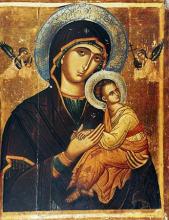 The Icon of the Mother of God "Of the Passion" received such a name because flanking the Mother of God are two angels holding the implements of the Lord's suffering: the Cross, the lance, and the sponge. The following information is known about the glorification of this Icon. After being married, a certain pious woman named Katherine began to suffer seizures and episodes of madness. She would lose her mind, and run off into the woods; on several occasions, she tried to commit suicide. In moments of lucidity, she would pray to the Mother of God, and vowed that, should she be healed, she would enter a monastery. Long after she recovered that she remembered her vow, and terrified and filled with spiritual dread, retired to her bed. The Most-holy Theotokos appeared to her three times, and ordered her to go to Nizhny Novgorod , and to buy her icon from the iconographer Gregory. As soon as she had done so, Katherine was healed; ever since, miracles have been flowing from that Icon. The Icon is celebrated on August 13, on the occasion of its being translated from the Village of Palitsa to Moscow in 1641.A church was built at the site of the meeting of the Icon at the gates of Tver, and in 1654, The Monastery of the Passion was established there. The second Feast Day of the Icon is the 6th Sunday after Pascha, the Sunday of the Blind Man, in commemoration of the miracles wrought on that day. Icons of the Passion have also been glorified in the Moscow Church Our Lady's Conception by St. Anna, and in the village of Enkaevo in the Tambov Diocese.
The Icon of the Mother of God "Of the Passion" received such a name because flanking the Mother of God are two angels holding the implements of the Lord's suffering: the Cross, the lance, and the sponge. The following information is known about the glorification of this Icon. After being married, a certain pious woman named Katherine began to suffer seizures and episodes of madness. She would lose her mind, and run off into the woods; on several occasions, she tried to commit suicide. In moments of lucidity, she would pray to the Mother of God, and vowed that, should she be healed, she would enter a monastery. Long after she recovered that she remembered her vow, and terrified and filled with spiritual dread, retired to her bed. The Most-holy Theotokos appeared to her three times, and ordered her to go to Nizhny Novgorod , and to buy her icon from the iconographer Gregory. As soon as she had done so, Katherine was healed; ever since, miracles have been flowing from that Icon. The Icon is celebrated on August 13, on the occasion of its being translated from the Village of Palitsa to Moscow in 1641.A church was built at the site of the meeting of the Icon at the gates of Tver, and in 1654, The Monastery of the Passion was established there. The second Feast Day of the Icon is the 6th Sunday after Pascha, the Sunday of the Blind Man, in commemoration of the miracles wrought on that day. Icons of the Passion have also been glorified in the Moscow Church Our Lady's Conception by St. Anna, and in the village of Enkaevo in the Tambov Diocese.
"Besednaya" Icon
14 / 27 August
 In 1383, soon after the miraculous appearance of the Tikhvin Icon of the Mother of God, a pious sexton named George was sent to herald to the surrounding villages the day of the consecration of the church dedicated to the appearance of the Icon, and to proclaim a fast. On his way back, some distance from Tikhvin, George suddenly saw the Mother of God, sitting on a pine log and shining forth with an indescribable light; in her hand, she held a crimson staff, and before her stood Holy Hierarch St. Nicholas the Wonderworker. The Most-holy Theotokos ordered George to tell the clergy that a wooden, and not an iron, cross should be put atop her church.
In 1383, soon after the miraculous appearance of the Tikhvin Icon of the Mother of God, a pious sexton named George was sent to herald to the surrounding villages the day of the consecration of the church dedicated to the appearance of the Icon, and to proclaim a fast. On his way back, some distance from Tikhvin, George suddenly saw the Mother of God, sitting on a pine log and shining forth with an indescribable light; in her hand, she held a crimson staff, and before her stood Holy Hierarch St. Nicholas the Wonderworker. The Most-holy Theotokos ordered George to tell the clergy that a wooden, and not an iron, cross should be put atop her church.
George carried out her command. However, the people lent no credence to his words, and began to install the iron cross already prepared for the church. A sudden storm threw the worker holding the iron cross from the roof without causing any harm either to the worker or to the cross.
On the site of the apparition, a church dedicated to St. Nicholas was erected. A cross made from the pine log was installed atop that church.
Seven years after the consecration of the church on the Tikhvin, as the result of a candle not being extinguished, the wooden church burned down; the Miraculous Icon of the Mother of God was invisibly removed from the fire, and was found about Ѕ kilometer away in a juniper. At the same time, so did the chapel built on the site of the apparition of the Mother of God to sexton George. Just like the Icon, the cross made from log upon which the Most-holy Theotokos had sat, was carried by some invisible force away from the flames and was found in the juniper bush. A new church and chapel were erected on the original sites, but five years later, both the church and the chapel simultaneously burst into flame. The Icon and the Cross were again miraculously spared. For the third time, they erected a wooden church and chapel. One hundred five years later, the chapel caught fire, but the fire was extinguished and the Miraculous Cross was saved. The entire church was consumed by the flames, but the priests were able to remove the Icon of the Mother of God from the conflagration.
Word of the miracles flowing from the Tikhvin Icon reached Great Prince Vasily Ioannovitch, who, after the church had burned down for the third time, ordered a stone church to be erected. Just as construction of the church was being completed, while they were finishing the courtyard, suddenly the scaffolding collapsed, crushing twenty workers. Everyone thought that the workers had been crushed to death. However, to everyone’s surprise, after three days of clearing away the stones, they found all of them alive. The Queen of Heaven had saved them. In 1515, at the direction of Great Prince Vasily Ioannovitch, a wooden church dedicated to the Mother of God and to St. Nicholas was erected in the wilderness where the chapel had stood. A men’s monastery also established there was called the Besedniy Monastery (i.e. Monastery of the “Beseda,” or “Conversation”), in honor of the past appearance of the Mother of God and St. Nicholas and their tender conversation with one of the humblest of servants of the Orthodox Church. The Icon depicting this apparition is known as the Besednaya Icon.
The Besedniy Monastery is in the Tikhvin District of Novgorod Province.
"Khakhylskaya" Icon
15 / 28 August
Near Kutaisi, former capital of Colchis, is the famous Gelati Monastery, dedicated to the Dormition of the Mother of God, and built in the eighth century by Saint David, king and founder of Iberia.
By far the most remarkable holy object in this ancient church is the Khakhuli Icon of the Theotokos, written by the Holy Evangelist Luke. The face of the Most-holy Theotokos is depicted in dark tones, and without the preeternal Infant; it is identical to the icon which is in the Winter Palace in St. Petersburg. On it is a riza of pure gold, decorated with precious stones. Many of these stones were donated by the renowned Queen Tamara. Tradition states that once, as Tamara was arranging precious stones in her coiffure in preparation for Divine Liturgy at the Gelati monastery, word came to her that at the door of her chamber stood a poor woman begging alms. The queen directed that the beggar wait a bit. Upon leaving her chamber, the queen intended to give the poor woman alms, but the woman was nowhere to be found. Tamara became very upset, for she recognized that in turning away that poor woman, she had turned away the Lord Himself. To punish herself, she removed the royal headband, which had been the cause of her delay, and placed it on the crown of the Mother of God.
In that same church is another holy and venerated icon: the Gelati or Atskura icon. The Gelati icon, like the Vlachernae icon, is not written, but is embossed in silver-gilt. The icon, in a rich silver shrine of exquisite craftsmanship and decorated with precious stones, was transferred from the city of Atskura by King Bagrat and brought to the Gelati Monastery by King Bagrat and Queen Helen. According to tradition, the Atskura icon of the Mother of God had been brought to Georgia by the St. Andrew the Apostle.
The Iveron Icon in Mozdok
12 / 25 February
This Icon belonged to the famous Queen Tamara, who was most renowned for her efforts to spread the Christian Faith among the peoples of the Caucasus Mountains. After a multitude of pagan Circassians adopted Christianity, she sent them an Icon of the Iveron Mother of God. From the days of Tamara (1184-1207) until 1768, the Icon remained in the mountains and became renowned as the source of many miracles. In two fires which destroyed the church housing the Icon, the Icon remained unharmed. In 1768, at the direction of Empress Catherine II, the inhabitants of Ossetia, moved away from the mountains and settled along the Terek border; with them, they brought the Miraculous Iveron Icon. The bishop of Mozdok organized a Procession of the Cross, greeted the Icon of the Mother of God, and after serving a moleben before it, expressed the intention to have it installed in his cathedral. However, the oxen harnessed to the cart containing the Icon refused to move from the spot. Crowds of people gathered to venerate the Miraculous Icon. Overjoyed at such a sign of God’s mercy, the residents of the area hurried to build a chapel to house the Iveron Icon. Later, in 1796, they erected a church on the site, and in it installed the grace-filled Icon. In times of sickness and misfortune, everyone would turn to the Queen of Heaven for help; Orthodox Georgians, Armenians, Circassians, and Ossetians all glorified her for working great miracles. According to folk tradition, in 1840, when Shamil was in Mozdok, a woman dressed in white appeared to him and his army, and forbade them from attacking the city.
The “Tinos” Icon
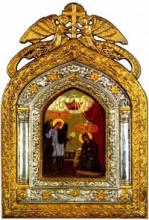 There are over 600 churches and monasteries on the Greek Island of Tinos, which is widely known for its miraculous healing Icon of the Mother of God.
There are over 600 churches and monasteries on the Greek Island of Tinos, which is widely known for its miraculous healing Icon of the Mother of God.
In June 1822, the Virgin Mary appeared several times to a nun named Sister Pelagia, in the Convent of Kerovounia. She pointed out to her the place in a field where the locals were to look for her Icon. The Icon was in fact found there on January 30, 1823; it was later confirmed that the place had once been the site of an ancient Christian church; in fact the exact spot where the Icon was found was in the church crypt. Now the place is known as the “Chapel of the Discovery.”
After the discovery, a new church was built on the site. It was completed in 1830, and is known as the Church of Megalochari (Great Grace). In those days, pilgrims were already coming to the island in order to venerate the Icon, which quickly gained renown as a source of healing. Now in Greece it is venerated as one of the most important holy things in the land.
The Church has recorded accounts of hundreds of healings attributed to the Miraculous Icon. Every year, tens of thousands of pilgrims come to Tinos from all over Greece and from abroad. The main Feast day of the Icon is August 15, the Feast of the Dormition of the Mother of God.
PARISH LIFE
RECENT VIDEOS
Address of our Cathedral
Subscribe to our mailing list
While all the materials on this site are copyrighted, you may use them freely as long as you treat them
with respect and provide attribution on the Russian Orthodox Cathedral of St.John the Baptist of Washington DC.
